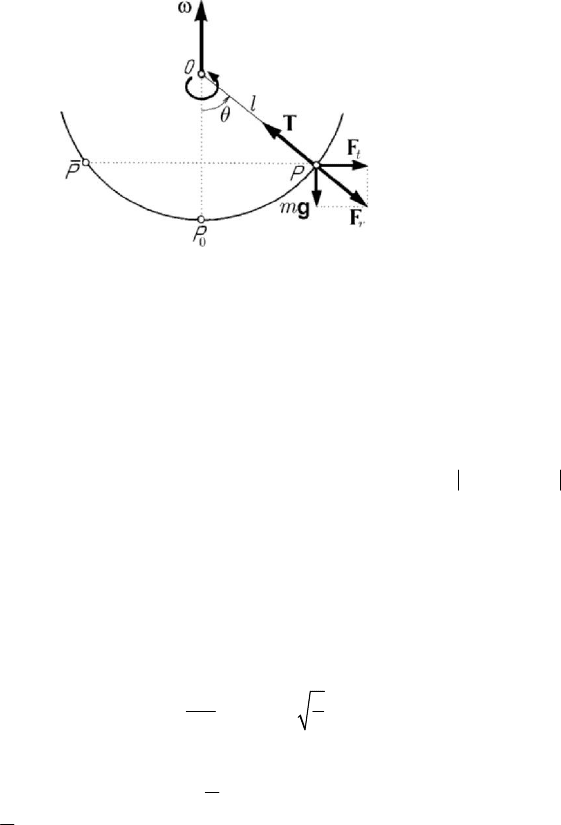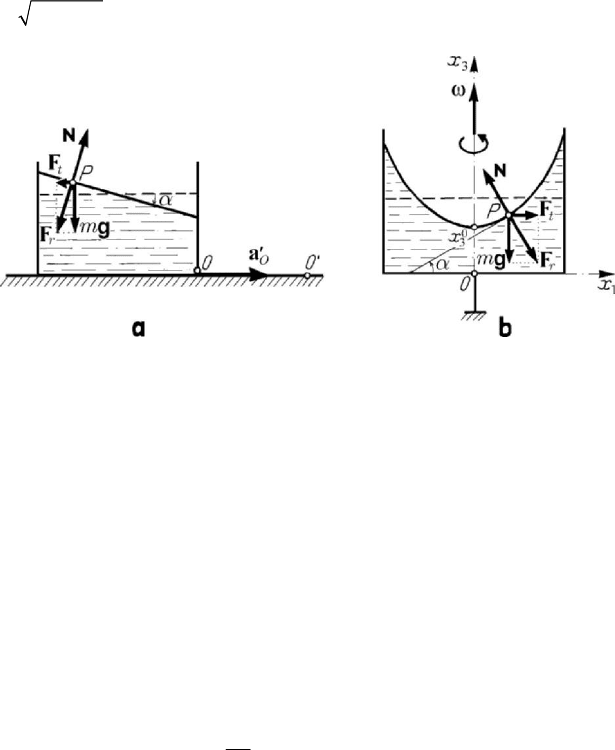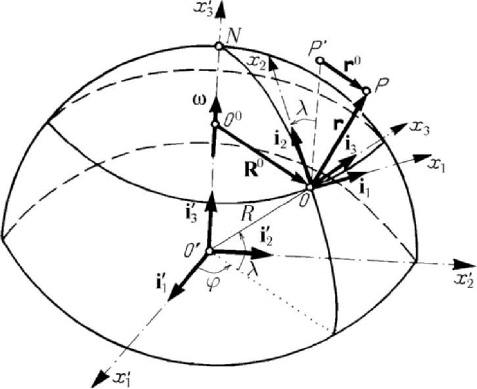Teodorescu P.P. Mechanical Systems, Classical Models Volume I: Particle Mechanics
Подождите немного. Документ загружается.


Other considerations on particle dynamics
623
Dividing the relation (10.2.15) by
dt , we get
rrr r
t
T
TP P
t
∂
===⋅=+⋅
∂
Fv Fv
(10.2.16)
so that we may state
Theorem 10.2.6' (theorem of kinetic energy; second form). The derivative with respect
to time of the kinetic energy of a free particle in a non-inertial frame of reference is
equal to the power of the relative force which acts upon it in this frame (the sum of the
power of the resultant of the given forces which act upon the particle and the power of
the transportation force).
In case of a particle subjected to bilateral constraints, we apply the axiom of
liberation of constraints and introduce the constraint force
R ; the formulae (10.2.11),
(10.2.12), (10.2.14) - (10.2.16) take the form
r
t
C
t
∂
==+=+++
∂
H
HFRFFFR
, (10.2.11')
∂
==×+=+×++
∂
K
KrFRMrFFM() ( )
O
O
r
t
OOC
t
, (10.2.12')
()
() ( ) () () ( ) ( ) ()
O
r
t
OOOOOOCO
t
∂τ
τ = =τ +τ =τ +τ +τ +τ
∂
H
HFRFFFR
,
(10.2.14')
dd d d d d d d
r
t
r
FR FR
TW W WW W=+=++=⋅+⋅FrRr
ddd
t
=⋅ + ⋅ +⋅FrF rRr, (10.2.15')
rr r r r
t
T
TP
t
∂
==⋅+⋅=+⋅+⋅
∂
F v Rv F v Rv
, (10.2.16')
so that we can state corresponding theorems. In case of holonomic and scleronomic
constraints we have
dd0
R
W =⋅ =Rr
, hence 0
r
⋅
=Rv .
Starting from the above results, we can find, in certain conditions, first integrals and
may state conservation theorems with respect to a non-inertial frame of reference. Thus,
using the theorems of Chap. 6, Subsec. 1.2.5, we obtain, for a free particle:
Theorem 10.2.7 (conservation theorem of momentum). The momentum (and the
velocity) of a free particle with respect to a non-inertial frame of reference is conserved
in time if and only if the relative force which acts upon the particle in this frame (the
sum of the resultant of the given forces which act upon the particle and the
complementary forces) vanishes.
Theorem 10.2.8 (conservation theorem of moment of momentum). The moment of
momentum of a free particle with respect to the pole of a non-inertial frame of
reference is conserved in time if and only if the moment of the relative force which acts
upon it in this frame (the sum of the moment of the resultant of the given forces which
act upon the particle and the moment of the complementary forces), with respect to the
same pole, vanishes.
Theorem 10.2.9 (conservation theorem of torsor). The torsor of the momentum of a
free particle with respect to the pole of a non-inertial frame of reference is conserved in

MECHANICAL SYSTEMS, CLASSICAL MODELS
624
time if and only if the torsor of the relative force which acts upon it in this frame (the
sum of the resultant of the given forces which act upon the particle and the
complementary forces), with respect to the same pole, vanishes.
Theorem 10.2.10 (conservation theorem of the mechanical energy). The mechanical
energy of a free particle with respect to a non-inertial frame of reference is conserved
in time if and only if the sum of the given forces which act upon the particle and the
transportation force is conservative.
The conditions in the latter theorem (in which the mechanical energy contains also
an energy due to the transportation force) are not so easy to fulfil. If the resultant
F
of
the given forces is a conservative one, which derives from a simple or from a
generalized potential, then we can write
dd( ) d
t
ETV
=
+=⋅Fr. (10.2.17)
In particular, if
O
′
=a0
(hence const
O
′
=
v
) and const=
ω
, hence if the
transportation motion is a finite motion of rototranslation of constant velocities of
translation and rotation (the movable frame has a motion of rotation with a constant
angular velocity around an axis which passes through its pole, that one having a
rectilinear and uniform motion with respect to the fixed frame), we can write
dd()d(,,d)(,,d)
tt
mm m m⋅=− ⋅=− ××⋅=− × = ×Fr a r r r rr r r
ω
ωωωωω
2
()(d)d()
2
m
m
⎡
⎤
=×⋅×= ×
⎣
⎦
rr rωω ω
we obtain thus a first integral (called, sometimes, the generalized first integral of the
energy, because it is reduced to the first integral of the energy if
=
0
ω
) of the form
2
()
2
m
ETV h=+= × +rω , consth
=
. (10.2.17')
In case of a particle subjected to constraints we get results analogous to those in
Chap. 6, Subsec. 2.1.3. If the constraints are holonomic and scleronomic, then the
relations (10.2.17), (10.2.17') maintain their form.
2.1.4 Inertial frames of reference. Galileo-Newton group
Starting from the equation (10.2.2), (10.2.2'), we will search the movable frames
(specified by the acceleration
O
′
a of the pole of the frame and by its angular velocity
ω
) for which a free particle P is moving after the law
r
m
=
aF, (10.2.18)
hence after the same law as in the case of the fixed (inertial) frame. We notice that, in
this case, the sum of the complementary forces must vanish; hence, we must have
[
]
() ()2
r
t
CO
mm
′
−+=− +×+××+×=
aa a r r v 0
ω
ωω ω (10.2.19)
Other considerations on particle dynamics
625
for any point at which the particle may be (for any
r ) and for any relative velocity
r
v
of it.
We assume that, starting from the same position vector
r , the particle P can have
the relative velocity
r
′
v
in one case of motion and the relative velocity
r
′′
v
in another
case of motion. Imposing the condition (10.2.19) in both cases and subtracting a
relation from the other, we find
()
rr
′
′′
×
−=vv 0
ω
for any
r
′
v and
r
′′
v
; it results that
we must have
= 0ω (hence,
=
0
ω
too). Returning to the above condition, it follows
that
O
′
=a0
.
From the latter condition we see that one passes from the fixed frame to the movable
one by a transformation of space co-ordinates (to which a time transformation may be
added) of the form (6.1.42''), which forms a group with seven parameters. The
condition
=
ω
0 shows that the movable frame can have only a finite geometric
rotation of the form (6.1.43), concerning its relative position with respect to the fixed
frame, so that the most general transformation which corresponds to the passing from a
frame to another one, modelling the motion of a particle in the form (10.2.18), is given
by (6.1.44) and forms the Galileo-Newton group with ten parameters, studied in Chap.
6, Subsec. 1.2.3. One can thus apply the Theorem 6.1.6 (of relativity) of Galileo, the
movable frame being – in this case – an inertial frame too, with respect to which the law
of motion maintains its form (acting only the given force and, eventually, the constraint
one). If we write the relation of transformation (6.1.44) for two particles
1
P
and
2
P
,
then we have
00
11
t
′
=++αrrvr,
00
22
t
′
=
++
α
rrvr,
0
ttt
′
=
+ ,
the tensor
α
corresponding to a finite rotation of the movable frame; we obtain thus
21 21
()
′′
−= −
α
rr rr, wherefrom
[][][][ ]
2
2
21 21 21 21 21 21
()() ()() ()()
′′
− = − = −⋅ −= −⋅−αααααrr rr rr rr rr rr
[
]
2
21 21 21
()()()=−⋅−=−δ rr rr rr,
δ being Kronecker’s tensor. Hence, the distance between two particles remains
invariant in a transformation of the Galileo-Newton group; the forces which depend
only on distances (e.g., the forces of Newtonian attraction) have the same property of
invariance. In this case, taking into account the invariance of the acceleration, it results
that the mass of the particle is invariant too (constant, property iii) of the mass; see also
Chap. 1, Subsec. 1.1.6).
If, in a non-inertial system of reference, we determine experimentally the sum
t
C
+FF of the complementary forces, then one calculate the quantities
O
′
a
and ω
which specify the motion of the frame (neglecting a rectilinear and uniform motion of
translation, which cannot be put in evidence by mechanical experiments). As a matter
of fact, by no experiment of physical (not only mechanical) nature a preferential inertial
(e.g., “fixed”) frame cannot be put in evidence, all inertial systems being thus
equivalent.
MECHANICAL SYSTEMS, CLASSICAL MODELS
626
2.1.5 Principle of equivalence
Let us suppose that the particle P is subjected to the action of a uniform
gravitational field (the terrestrial gravitational field)
m
=
Fg and let us consider the
motion with respect to a non-inertial frame of reference in rectilinear and uniform
accelerated motion of translation (hence, for which
O
′
=
ag,
=
ω
0 ); in this case,
t
m=−Fg and
C
=F0, so that
r
=
F0, the equation of motion (10.2.2') leading thus
to
r
=a0. We notice that an observer, situated in an elevator which is moving in the
direction of the gravitation and is acted upon by a force equal to
mg , cannot perceive
the gravitational field (particularly, if he could not be in contact with the universe of the
exterior of the elevator); it is the case of imponderability, considered in Subsec. 2.1.2.
The mass plays two different rôles in the identity
O
mm
′
=
ag; in the left member is
put in evidence the aspect of inertial mass (which leads to the inertial transportation
force), while in the right member appears the aspect of gravity mass (called heavy mass
too) (see also Chap. 1, Subsecs 1.1.6 and 1.2.1). This observation led A. Einstein to
state the principle of equivalence between the gravity mass and the inertial one in the
general relativistic model of mechanics; thus, the two properties of the mass represent
two different aspects of the same material quantity. This result has been confirmed by
the experiments performed by Eötvös and Zeeman, by Southern and Zeeman etc.
2.1.6 Relative equilibrium
The location
0
=rr is called position of relative equilibrium of a free particle P
(which is in relative rest with respect to a non-inertial frame of reference) if the
equation of motion (10.2.2), (10.2.2') with the initial conditions
00
()t =rr,
0
()
r
t =v0 admits as solution
0
()t
=
rr,
0
tt
∀
≥ ; in this case, we have ()
r
t =v0,
()t =a0,
0
tt
∀
≥ . It results
C
=
F0, so that
r
t
=
+=FFF0, (10.2.20)
and we can state (the condition (10.2.20) is sufficient too, because
C
=F0 leads to
r
=v0, the rectilinear and uniform motion with respect to the movable frame being
thus excluded)
Theorem 10.2.11 (theorem of relative equilibrium). A free particle is in relative
equilibrium (with respect to a non-inertial frame of reference) if and only if the sum of
the resultant of the given forces which act upon that particle and the transportation
force vanishes.
If
O
′
=a0
, =
ω 0 (the non-inertial frame has a finite motion of rototranslation with
constant velocities of translation and rotation), then the transportation force
()
t
m
=
−××
ω
ωFr (10.2.21)
is a centrifugal one.

Other considerations on particle dynamics
627
In case of a particle subjected to bilateral constraints, the necessary and sufficient
condition of relative equilibrium (with respect to a non-inertial frame of reference)
reads
r
t
+
=+ + =FRFFR0, (10.2.20')
where
R is the constraint force.
Figure 10.6. Heavy particle constrained to move on a circle in uniform rotation
about a vertical diameter of it.
Let us consider the case of a heavy particle
P of mass m , constrained to move on a
circle in uniform rotation about a vertical diameter of it, with the angular velocity
ω
(along one of the axes of the inertial frame of pole
O ); for instance, let us suppose that
the particle
P is a small heavy sphere, situated at the end of a perfect inextensible
thread of length
l (Fig.10.6). We choose the non-inertial frame with the pole at O too,
the axis of which coincides with the rotation axis of the movable frame. The particle is
acted upon by the gravity force
mg , by the centrifugal force ()
t
Fm
=
××rωω
2
sinmlωθ= and by the constraint force T (the tension in the thread). Projecting the
equation of equilibrium (
t
m
+
+=gF T 0) on the normal to the force T and along
the direction of it, we get
cos sin
t
Fmgθθ
=
,
sin cos
t
TF mgθθ
=
+
.
The positions of relative equilibrium are given by
sin 0θ = ,
2
cos
g
l
θ
ω
= ,
g
l
ω∀> ; (10.2.22)
hence, excepting the point
0
P (which corresponds to 0θ
=
), we obtain two symmetric
positions of relative equilibrium
P and P . For
0
P it results the tension Tmg= ,
while for
P and P the tension is
2
Tmlω
=
.
Let be an ideal liquid in rest with respect to a vessel in uniform accelerated
translation with respect to an inertial frame of pole
O
′
; the non-inertial frame is linked

MECHANICAL SYSTEMS, CLASSICAL MODELS
628
to the vessel, the velocity of the pole
O
being
const
O
′
=
a
with respect to the pole O
′
.
If
O
′
=a0
, then the free surface of the liquid (in rest with respect to the fixed frame) is
a horizontal plane. A particle
P
, of mass m , of the free surface of the fluid
(Fig.10.7,a) is in equilibrium under the action of the gravity force
mg , of the
transportation force
t
O
m
′
=−Fa and of the constraint force N (normal to the
separation surface). If the liquid is in relative equilibrium with respect to the vessel in
motion of translation, then the free surface is a plane inclined with respect to the
horizontal one by an angle
α given by tan /
O
agα
′
=
, while the constraint force is
22
O
Nma g
′
=+.
Figure 10.7. Relative equilibrium of a liquid with respect to a vessel in uniform accelerated
translation (a) or in uniform motion of rotation about a vertical axis of symmetry (b).
If the vessel has a uniform motion of rotation about a vertical axis of symmetry,
linked to the fixed frame, the movable frame being connected to the vessel, then a
particle
P
, of mass m , of the separation surface of the fluid is acted upon by the
gravity force
mg , by the centrifugal force ()
t
m
=
−××
ω
ωFr, of magnitude
2
1
t
Fmxω=
, and by the constraint force
N (Fig.10.7,b). Projecting the equation of
relative equilibrium (
t
m ++=gF N 0) on the tangent at P to the meridian curve of
the free surface, we get
2
1
cos sinmx mgωα α= ; observing that
31
tan d / dxxα = , it
results
2
31 1
d/d /xx xgω= , the meridian curve being a parabola of equation
(
)
220
313
/2xgxxω=+
. Hence, the free surface is an axial-symmetrical paraboloid of
equation
()
2
22 0
3123
2
xxxx
g
ω
=++. (10.2.23)
As well, the constraint force is given by
/cosNmg α
=
.

Other considerations on particle dynamics
629
2.2 Elements of terrestrial mechanics
After a study of the influence of the transportation force (inclusive of the centrifugal
force) and of Coriolis’ force on the motion of a particle on Earth’s surface (using a
geocentric or a heliocentric frame), some phenomena due to non-inertial frames on the
Earth surface are considered. Thus, the phenomenon of tides is explained, the terrestrial
acceleration is calculated, the deviation of the plummet from the local vertical, the
deviation towards the east in free falling and Baer’s law are determined and the idea of
imponderability is explained; as well, Foucault’s pendulum, very important for the
knowledge of terrestrial motions, is presented. In particular, one obtains the case of
relative equilibrium.
2.2.1 Geocentric and heliocentric frames
In the study of motion of a particle on the Earth surface, we considered till now that
the local frame of reference is inertial (absolute); we obtained thus the motion of the
particle with respect to this frame, where the motion of the Earth was not taken into
consideration (an approximation of the physical reality). Assuming that the Earth is
spherical, we choose the orthonormal frame with the pole at a point
O on the boreal
Figure 10.8. Motion of a particle with respect to a geocentric (inertial) frame of reference.
hemisphere; the
1
Ox -axis is tangent to the parallel of the point O , being directed
towards the east point, the
2
Ox -axis is tangent to the local meridian, being directed
towards the north, while the
3
Ox -axis is directed towards the ascendent local vertical
(the same direction as
OO
′
, O
′
being the centre of the Earth (Fig.10.8). If a heavy
particle falls free from the height
h (sufficient great, without other influences) and if
we assume that the considered frame of reference is inertial, then the equations of the
rectilinear trajectory are
12
0xx
=
= ,
2
3
/2xhgt=− ; but, experimentally, it is seen

MECHANICAL SYSTEMS, CLASSICAL MODELS
630
that a deviation towards the east point, along the parallel (
1
0x
≠
) takes place. This
deviation is, obviously, due to Earth’s motion of rotation (the local frame of reference is
non-inertial). The most simple frame which can be chosen as an inertial one is the
geocentric frame of reference (Ptolemy’s frame), assuming that the pole is at the centre
O
′
of the Earth; usually, the equatorial plane is taken as principal plane, the
1
Ox
′′
-axis
being directed towards the vernal equinoctial point (on the celestial sphere of radius
equal to unity, at the intersection of the equatorial plane with the ecliptic plane, which
contains the orbit of the Earth), while the
3
Ox
′
′
-axis is normal to that plane (hence, it is
the rotation axis of the Earth) (Fig.10.8). Practically, a system of stars considered
“fixed”, which allows to specify the axes of the considered frame, is used.
The local frame of reference is rigidly linked to the Earth, hence it has a motion of
rotation defined by the vector
ω
, directed along the axis of the poles, from the south to
the north. We notice that a complete rotation of the Earth about its axis takes place in a
sidereal day, which is smaller than a mean solar day by
3 min 56 s; hence, a sidereal
day has
24 60 60 (3 60 56) 86164 s⋅⋅−⋅+ = (seconds of mean solar time), so that
the magnitude of the vector is given by
5
2
7.292 10 rad/ s
86164
π
ω
−
=≅⋅ , (10.2.24)
the unit of time being the second. In the non-inertial frame of unit vectors
j
i ,
1, 2, 3j = , the rotation vector is given by
21
cos sinωλ ωλ
=
+
ω
ii, (10.2.25)
where
λ ,
[
]
0, / 2λπ∈ in the boreal hemisphere and
[
]
/2,0λπ
∈
− in the austral
hemisphere, is the local latitude. The unit vectors of the axes of the two frames are
linked by the relations
112
sin cosϕϕ
′
′
=
−+iii,
2123
sin cos sin sin cosλϕ λϕ λ
′
′′
=− − +iiii
, (10.2.26)
3123
coscos cossin sinλϕ λϕ λ
′
′′
=++iiii
,
where
ϕ , [0,2 )ϕπ∈ , is the local longitude. Taking into account (A.2.36) and the fact
that the pole of the movable frame has a circular motion along the parallel of radius
cosR λ , where R is Earth’s radius, we get
1
0ω = ,
2
cosωϕλ
=
,
3
sinωϕλ
=
; (10.2.25')
observing that
ωϕ= , the formulae (10.2.25') correspond to the expression (10.2.25)
previously obtained for the rotation vector, what was to be expected, taking into
account the results in Chap. 5, Subsec. 2.2.2.

Other considerations on particle dynamics
631
But there are some phenomena for which the use of a geocentric frame of reference
leads to results which are not in concordance with the physical reality; in this case, one
must choose another frame as inertial one, i.e. a heliocentric frame (Copernicus’ frame),
with the pole
O
′′
at the centre of mass of the Sun (very close to the centre of mass of
the solar system, which – as it will be shown in Chap. 11, Subsec. 1.2.5 – has a
rectilinear and uniform motion). The heliocentric frame may be ecliptic or equatorial, as
it has been shown in Chap. 1, Subsec. 1.1.4, its axes
1
Ox
′
′′′
,
2
Ox
′
′′′
,
3
Ox
′′ ′′
being
specified correspondingly. The geocentric frame previously considered is, in this case, a
non-inertial one, its axes having fixed directions (the corresponding rotation vector
′
ω
is equal to zero); indeed, corresponding to Kepler’s first law, the Earth has also a
motion of revolution which is – in fact – a motion of translation.
If neither the heliocentric frame of reference cannot be considered to be inertial, then
one can choose a galactocentric frame a.s.o.
2.2.2 Motion of a particle at the Earth surface. Relative equilibrium
Let us consider, first of all, the case of a heliocentric frame (an inertial frame), the
geocentric one being non-inertial. The equation of motion (10.2.2') with respect to the
latter frame of reference is written in the form (neglecting the effect of the centrifugal
force due to the motion of revolution of the Earth; Coriolis’ force vanishes, because the
motion is plane)
r
O
mm
′
′
′′′
=
−aF a, (10.2.27)
where
O
OO
′
′′ ′′ ′
=
r
, while
′
F is the force which acts upon the particle
P
of mass m .
Let (
f
C
is, in fact, an acceleration)
3
()
Q
Q
mm
mQ f CQ
CQ
=−
f
C
C
(10.2.28)
be the force of universal attraction by which a celestial body
C of centre C and mass
m
C
acts upon a particle Q of mass
Q
m
. With respect to the heliocentric frame, the
equation of motion of an element of mass
d()d
E
mQVμ
=
of the Earth, situated at
the point of position vector
Q
r , reads
() d () ()d
j
Q
j
QV QQVμμ
′′
=
∑
af
C
,
where we have put into evidence the action of the celestial bodies
j
C
, 1,2,...j = ,
upon that element; but (
V is the volume of the Earth)
()
22
22
dd
() d () d
dd
QQEQEQ
VV
QV QV m m
tt
μμ
′′ ′′ ′′ ′′
===
∫∫
arra,
where we took into account the formula (3.1.3), which gives the position of the centre
of mass
O
′
of the Earth, so that we get

MECHANICAL SYSTEMS, CLASSICAL MODELS
632
() ()d
j
E
O
V
j
mQQVμ
′
′′
=
∑
∫
af
C
,
()d
E
V
mQVμ=
∫
.
Finally, the equation of motion (10.2.27) becomes
[
]
() () ()
j
r
EM P
j
mmPPmP
′
=+ + +
∑
aF f f f
() () () ()d
j
SM P
V
E
j
m
QQ Q QV
m
μ
⎡⎤
−++
⎢⎥
⎣⎦
∑
∫
ff f , (10.2.29)
where
F is the resultant of the other forces which act upon the particle P (forces of
resistance of the medium, forces of friction, forces of electromagnetic nature etc.) and
where we have put into evidence the action of the Sun, of the Moon and of the other
planets
j
P ,
1,2,...j =
. Neglecting the action of the planets in comparison with the
action of the Sun and of the Moon, because of the great distances from these planets to
the Earth, and applying a mean value theorem, we can write, with a good
approximation,
[]
() () ()d
ESM
O
V
mOOQVμ
′
′′ ′ ′
=+
∫
af f ,
so that
33
() ()
SM
SM M
O
M
mm
OOfOOfOO
OO O O
′
′′ ′ ′ ′′ ′ ′
=+ =− −
′′ ′ ′
af f , (10.2.28')
where
M
O is the centre of the Moon. The equations (10.2.29) become
[
]
[
]
() () ( ) () ( )
r
ESS MM
mmPmPOmPO
′′′
=
++ −+ −aF f f f f f . (10.2.29')
Observing that
2
()
E
E
m
Pf
R
=f
,
2
()
S
S
m
Of
OO
′
=
′
′′
f
,
2
()
M
M
M
m
Of
OO
′
=
′
f
,
we may write
(
)
2
4
()
6.040 10
()
S
S
EE
O
m
R
Pm
OO
−
′
=≅⋅
′′ ′
f
f
,
2
6
()
3.379 10
()
M
M
EE
M
O
m
R
Pm
OO
−
′
⎛⎞
=≅⋅
⎜⎟
′
⎝⎠
f
f
,
where we took into account the relations
5
3.330 10
SE
mm=⋅ , 81.301
EM
mm≅ ,
4
2.348 10OO R
′′ ′
≅⋅, 60.336
M
OO R
′
≅ (in fact, the distance OO
′′ ′
put into
